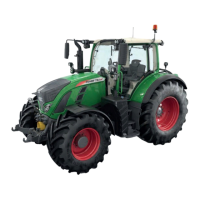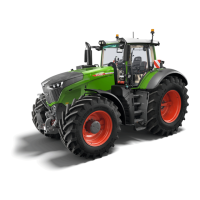2.6.3.1 Re-fill with coolant
Procedure
1.
Slowly twist the cap (A) a half turn to release
the overpressure.
2.
Remove the cover.
3.
Add coolant through the filler neck until the
expansion tank is full.
NOTE: There is no MIN or MAX mark on the
tank; the check is carried out only by using
the display on the terminal.
4.
Replace the cap (A) and turn as far as it will
go.
5.
With the heater switched on, run the engine
for about 10 minutes (at about 1,500 rpm).
6.
Check the coolant level on the display when
the engine is cold.
Fig. 31
NOTE:
The proportion of corrosion inhibitor/antifreeze in the cooling system should be at least 50 percent. This
will protect the cooling system from freezing down to approx. -37°C. A higher concentration is only
appropriate at even lower ambient temperatures. The corrosion inhibitor and antifreeze offer protection
against freezing down to a temperature of about -45°C. The corrosion inhibitor/antifreeze concentration
should not be more than 55% as maximum protection against freezing is achieved at this level. A higher
concentration reduces the anti-freezing effect and actually impairs the dissipation of heat. Reduced
dissipation of heat can in turn result in damage to cooling system components and/or the engine.
Check for any leaks in the lines or hose connections (including the heating system).
NOTE:
The coolant is a mixture of water and corrosion inhibitor/antifreeze. This ensures protection against
corrosion, protection against freezing and an increase in the boiling point. For this reason, coolant should
be topped up even in frost-free environments.
2.6.3.2 Drain coolant
Drain coolant
DANGER:
Danger of scalding from hot coolant spraying out when opening the coolant expansion
tank. The cooling system and coolant expansion tank are under pressure when the engine
is at operating temperature. Wear protective clothing and protective goggles. Only open
the coolant expansion tank when the coolant is at a temperature below 50°C.
DANGER:
The coolant contains glycol and is therefore toxic. Do not swallow coolant! If coolant is
swallowed, consult a doctor immediately. Ensure that coolant does not come into contact
with eyes, skin or clothing. If coolant comes into contact with the eyes, rinse immediately
with plenty of clean water. Skin and clothing should be cleaned immediately with soap
and water if they come into contact with the coolant; change affected clothing
immediately.
2. Service and maintenance
Maintenance 39
530.020.020.011 Rev.A

